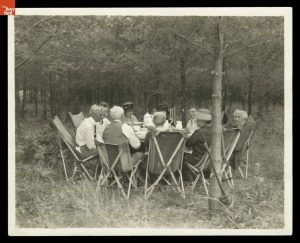The Vagabonds Land in the U.P.
On this day in history—August 17, 1923—three of America’s most iconic innovators set foot in Michigan’s Upper Peninsula. They arrived for a camping trip that was anything but rustic. Henry Ford, Thomas Edison, and Harvey Firestone, along with their wives, friends, and an entourage of staff, arrived in Escanaba aboard Ford’s massive luxury yacht, Sialia. The group, known as “The Vagabonds,” wasn’t just on a vacation—they were making history.
The Sialia, a 300-foot sea-going vessel equipped with every modern safety and comfort feature, cruised through dense fog across Lake Michigan after a tour of the Lower Peninsula. It docked in Escanaba around 3 a.m., where hundreds of excited locals gathered to catch a glimpse of the industrial titans. Enthusiastic cheers of “the greatest inventor in the world” greeted Thomas Edison. Henry Ford was mistaken more than once for E.G. Kingsford, Ford’s right-hand man in the Upper Peninsula and namesake of the town of Kingsford.
Disembarking with precision and style, the group transferred to three Lincoln sedans. Trucks loaded with tents, cots, and even a pantry car trailed the sedans. Their destination: Cowboy Lake near Iron Mountain, a private grove close to Ford’s regional plant operations. A Japanese cook and helper, chauffeurs, and a portable Edison generator ensured this was no ordinary wilderness excursion.

In 1923, the Vagabonds and their wives visited Michigan’s Upper Peninsula. Object ID 84.1.1660.P.188.5412 From the Collections of The Henry Ford. Gift of Ford Motor Company.
Lunch in the Wilderness
That afternoon, the party enjoyed a lavish luncheon around a custom-built round table. The table had a rotating center so no one had to reach for the potato salad. A movie cameraman documented the moments. A practice Ford insisted upon for personal records and family legacy. The photos and footage were never meant for public release. They were meant for the future Ford generation, including a young Henry Ford II.
Perhaps the most historically significant aspect of the 1923 trip came courtesy of Harvey Firestone. One of the cars used by the Vagabonds was outfitted with his newly developed balloon tires. Large, soft, air-filled innovations introduced just months earlier in April 1923. These tires only needed 20–30 psi and measured seven inches in diameter. They offered a smoother, more comfortable ride and would go on to revolutionize automotive travel.
Roughing It?
Despite their reputation for “roughing it,” the Vagabonds’ adventures were more a blend of glamping and corporate camaraderie, packed with innovation, conversation, and carefully choreographed press moments. Their annual trips were more than getaways—they were cultural touchpoints that showcased the intersection of industry, leisure, and media.
So, while today’s campers might haul a Yeti cooler and a folding chair to a rustic site, Henry Ford and company rolled into the woods with a portable kitchen, a film crew, and a 300-foot yacht. Only in the 1920s—and only with the Vagabonds.


